Stewart J. Calculus
Подождите немного. Документ загружается.


392
|| ||
CHAPTER 7 INVERSE FUNCTIONS
43. Use a computer algebra system to find an explicit expression
for the inverse function . (Your
CAS will produce three possible expressions. Explain why
two of them are irrelevant in this context.)
44. Show that , , is not one-to-one, but its
restriction , , is one-to-one.
Compute the derivative of by the method of
Note 2.
45. (a) If we shift a curve to the left, what happens to its reflec-
tion about the line ? In view of this geometric
principle, find an expression for the inverse of
, where is a one-to-one function.
(b) Find an expression for the inverse of ,
where .
46. (a) If is a one-to-one, twice differentiable function with
inverse function , show that
(b) Deduce that if is increasing and concave upward, then
its inverse function is concave downward.
f
t*!x" ! !
f *!t!x""
# f $! t!x""$
3
t
f
c " 0
h!x" ! f !cx"
ft!x" ! f !x # c"
y ! x
f
!1
! sin
!1
!
&
%2 ) x )
&
%2f !x" ! sin x
x ! !h!x" ! sin x
f !x" !
s
x
3
# x
2
# x # 1
CAS
(d) Calculate from the formula in part (c) and check
that it agrees with the result of part (b).
(e) Sketch the graphs of and on the same axes.
33. ,
34. ,
35. , ,
36. , ,
37– 40 Find .
37. ,
38. ,
, ,
40. ,
Suppose is the inverse function of a differentiable func-
tion and . Find .
42. Suppose is the inverse function of a differentiable func-
tion and let . If and ,
find .G$!2"
f $!3" !
1
9
f !3" ! 2G!x" ! 1%f
!1
!x"f
f
!1
! f
!1
"$!5"f $!4" !
2
3
f !4" ! 5,f
f
!1
41.
a ! 2f !x" !
s
x
3
# x
2
# x # 1
a ! 3
!1
+
x
+
1
f !x" ! 3 # x
2
# tan!
&
x%2"
39.
a ! 2f !x" ! x
3
# 3 sin x # 2 cos x
a ! 4f !x" ! 2x
3
# 3x
2
# 7x # 4
! f
!1
"$!a"
a ! 2x ( 1f !x" ! 1%!x ! 1"
a ! 80 ) x ) 3f !x" ! 9 ! x
2
a ! 2f !x" !
s
x ! 2
a ! 8f !x" ! x
3
f
!1
f
! f
!1
"$!a"
EXPONENTIAL FUNCTIONS AND THEIR DERIVATIVES
The function is called an exponential function because the variable, x, is the
exponent. It should not be confused with the power function , in which the vari-
able is the base.
In general, an exponential function is a function of the form
where is a positive constant. Let’s recall what this means.
If , a positive integer, then
n factors
If , and if , where is a positive integer, then
If is a rational number, , where and are integers and , then
But what is the meaning of if x is an irrational number? For instance, what is meant by
or ?
To help us answer this question we first look at the graph of the function , where
x is rational. A representation of this graph is shown in Figure 1. We want to enlarge the
domain of to include both rational and irrational numbers.y ! 2
x
y ! 2
x
5
&
2
s
3
a
x
a
x
! a
p%q
!
q
s
a
p
!
(
q
s
a
)
p
q ( 0qpx ! p%qx
a
!n
!
1
a
n
nx ! !nx ! 0, then a
0
! 1
a
n
! a " a " , , , " a
x ! n
a
f !x" ! a
x
t!x" ! x
2
f !x" ! 2
x
7.2
F I G U R E 1
Representation of y=2®, x rational
x
0
y
1
1
N If your instructor has assigned Sections 7.2*,
7.3*, and 7.4*, you don’t need to read
Sections 7.2–7.4 (pp. 392–421).
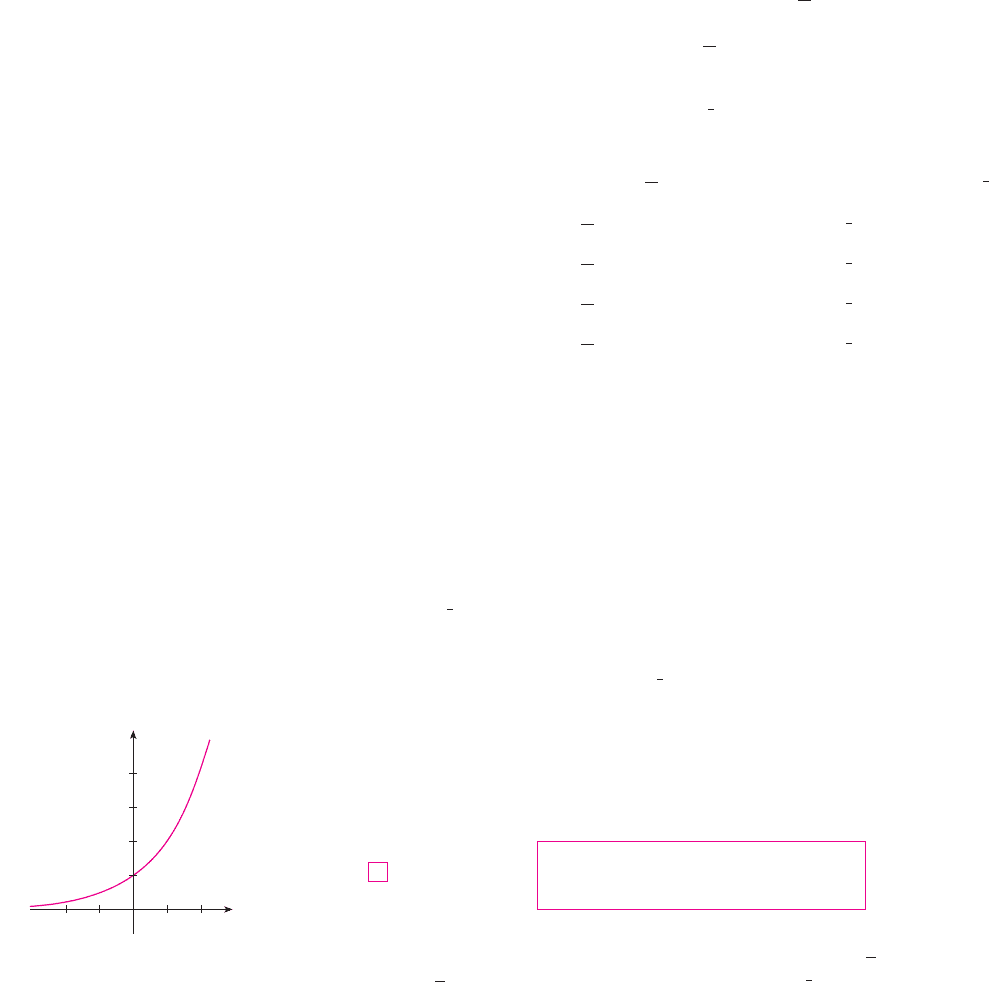
There are holes in the graph in Figure 1 corresponding to irrational values of x. We want
to fill in the holes by defining , where , so that is an increasing continu-
ous function. In particular, since the irrational number satisfies
we must have
and we know what and mean because 1.7 and 1.8 are rational numbers. Similarly,
if we use better approximations for , we obtain better approximations for :
. . . .
. . . .
. . . .
It can be shown that there is exactly one number that is greater than all of the numbers
. . .
and less than all of the numbers
. . .
We define to be this number. Using the preceding approximation process we can com-
pute it correct to six decimal places:
Similarly, we can define (or , if ) where x is any irrational number. Figure 2
shows how all the holes in Figure 1 have been filled to complete the graph of the function
.
In general, if is any positive number, we define
This definition makes sense because any irrational number can be approximated as
closely as we like by a rational number. For instance, because has the decimal repre-
sentation . . . , Definition 1 says that is the limit of the sequence of
numbers
Similarly, is the limit of the sequence of numbers
It can be shown that Definition 1 uniquely specifies and makes the function
continuous.
f !x" ! a
x
a
x
5
3.1
, 5
3.14
, 5
3.141
, 5
3.1415
, 5
3.14159
, 5
3.141592
, 5
3.1415926
, . . .
5
&
2
1.7
, 2
1.73
, 2
1.732
, 2
1.7320
, 2
1.73205
, 2
1.732050
, 2
1.7320508
, . . .
2
s
3
s
3
! 1.7320508
s
3
a
x
! lim
r l x
a
r
r rational
1
a
f !x" ! 2
x
, x ! !
a ( 0a
x
2
x
2
s
3
) 3.321997
2
s
3
2
1.73206
, 2
1.7321
, 2
1.733
, 2
1.74
, 2
1.8
,
2
1.73205
, 2
1.7320
, 2
1.732
, 2
1.73
, 2
1.7
,
1.73205
+
s
3
+
1.73206 ? 2
1.73205
+
2
s
3
+
2
1.73206
1.7320
+
s
3
+
1.7321 ? 2
1.7320
+
2
s
3
+
2
1.7321
1.732
+
s
3
+
1.733 ? 2
1.732
+
2
s
3
+
2
1.733
1.73
+
s
3
+
1.74 ? 2
1.73
+
2
s
3
+
2
1.74
2
s
3
s
3
2
1.8
2
1.7
2
1.7
+
2
s
3
+
2
1.8
1.7
+
s
3
+
1.8
s
3
fx ! !f !x" ! 2
x
SECTION 7.2 EXPONENTIAL FUNCTIONS AND THEIR DERIVATIVES
|| ||
393
x
1
0
y
1
F I G U R E 2
y
=2®, x real
N A proof of this fact is given in J. Marsden
and A. Weinstein,
Calculus Unlimited
(Menlo
Park, CA: Benjamin/Cummings, 1981). For an
online version, see
www.cds.caltech.edu/~marsden/
volume/cu/CU.pdf
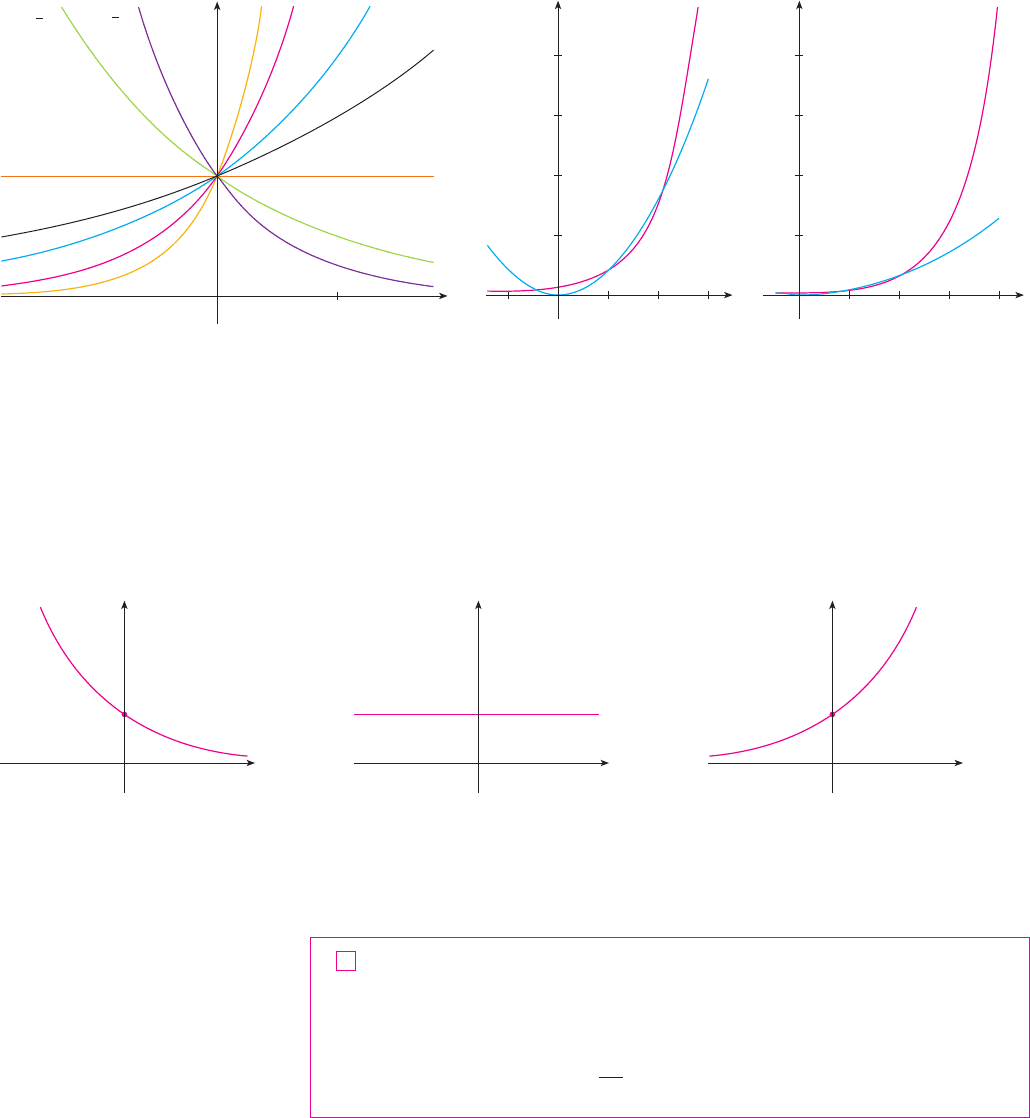
The graphs of members of the family of functions are shown in Figure 3 for var-
ious values of the base a. Notice that all of these graphs pass through the same point
because for . Notice also that as the base a gets larger, the exponential func-
tion grows more rapidly (for ).
Figure 4 shows how the exponential function compares with the power function
. The graphs intersect three times, but ultimately the exponential curve
grows far more rapidly than the parabola . (See also Figure 5.)
You can see from Figure 3 that there are basically three kinds of exponential functions
. If , the exponential function decreases; if , it is a constant;
and if , it increases. These three cases are illustrated in Figure 6. Since
, the graph of is just the reflection of the graph of
about the -axis.
The properties of the exponential function are summarized in the following theorem.
THEOREM If and , then is a continuous function with
domain and range . In particular, for all . If
is a decreasing function; if , is an increasing function. If , and
, , then
1. 2. 3. 4.
!ab"
x
! a
x
b
x
!a
x
"
y
! a
xy
a
x!y
!
a
x
a
y
a
x"y
! a
x
a
y
y ! !x
b # 0afa # 1
0
$
a
$
1, f !x" ! a
x
xa
x
# 0!0, %"!
f !x" ! a
x
a " 1a # 0
2
1
(0,1)
(a) y=a®, 0<a<1 (b) y=1® (c) y=a®, a>1
(0,1)
F I G U R E 6
x
0
y
x
0
y
x
0
y
y
y ! a
x
y ! !1#a"
x
!1#a"
x
! 1#a
x
! a
!x
a # 1
a ! 1
0
$
a
$
1
y ! a
x
y ! x
2
y ! 2
x
y ! x
2
y ! 2
x
F I G U R E 3
x
0
y
2
y=2®
4
y=≈
100
200
6
F I G U R E 5
x
0
y
2
4
10
y=2®
y=≈
F I G U R E 4
x
0
y
1
1®
1.5®
2®
4®
10®
”’
®
1
4
”’
®
1
2
x # 0
a " 0a
0
! 1
!0, 1"
y ! a
x
394
|| ||
CHAPTER 7 INVERSE FUNCTIONS
Members of the family of
exponential functions
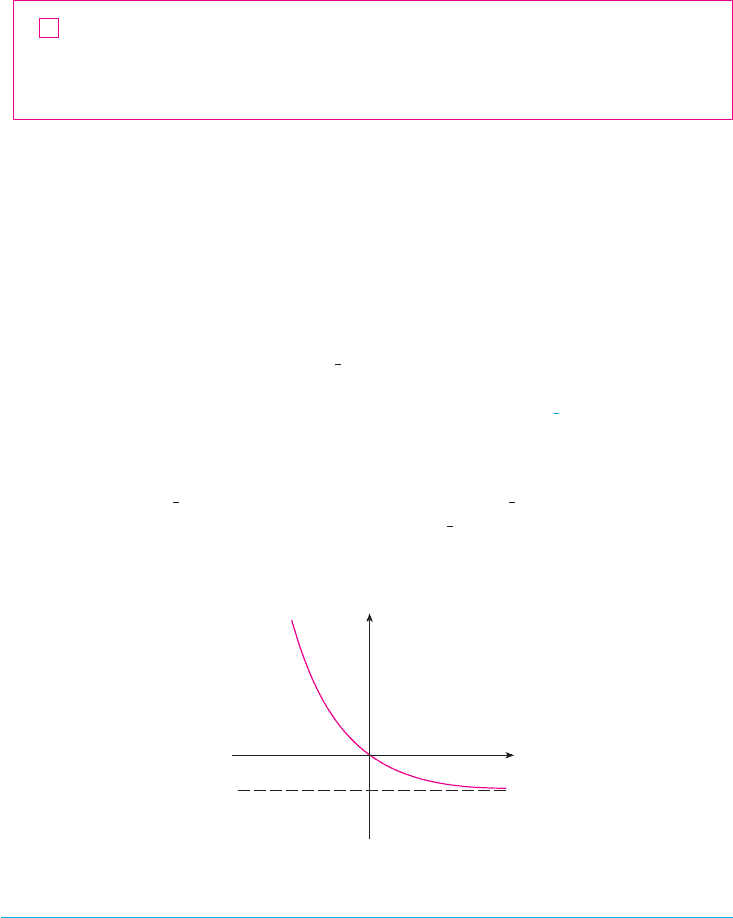
The reason for the importance of the exponential function lies in properties 1–4, which
are called the Laws of Exponents. If and are rational numbers, then these laws are well
known from elementary algebra. For arbitrary real numbers and these laws can be
deduced from the special case where the exponents are rational by using Equation 1.
The following limits can be read from the graphs shown in Figure 6 or proved from the
definition of a limit at infinity. (See Exercise 69 in Section 7.3.)
In particular, if , then the -axis is a horizontal asymptote of the graph of the expo-
nential function .
EXAMPLE 1
(a) Find .
(b) Sketch the graph of the function .
SOLUTION
(a)
[
by (3) with
]
(b) We write as in part (a). The graph of is shown in Figure 3, so
we shift it down one unit to obtain the graph of shown in Figure 7. (For a
review of shifting graphs, see Section 1.3.) Part (a) shows that the line is a hori-
zontal asymptote.
M
APPLICATIONS OF EXPONENTIAL FUNCTIONS
The exponential function occurs very frequently in mathematical models of nature and
society. Here we indicate briefly how it arises in the description of population growth.
In Section 7.5 we will pursue these and other applications in greater detail.
In Section 3.7 we considered a bacteria population that doubles every hour and saw that
if the initial population is , then the population after t hours is given by the function
. This population function is a constant multiple of the exponential function f !t" ! n
0
2
t
n
0
x
0
y
y=_1
y=2–®-1
F I G U R E 7
y ! !1
y !
(
1
2
)
x
! 1
y !
(
1
2
)
x
y !
(
1
2
)
x
! 1
! !1
a !
1
2
$
1 ! 0 ! 1
lim
x l %
!2
!x
! 1" ! lim
x l %
[(
1
2
)
x
! 1
]
y ! 2
!x
! 1
lim
x l %
!2
!x
! 1"
y ! a
x
xa " 1
If 0
$
a
$
1, then lim
x l %
a
x
! 0
and lim
x l !%
a
x
! %
If a # 1, then lim
x l %
a
x
! %
and lim
x l !%
a
x
! 0
3
yx
yx
SECTION 7.2 EXPONENTIAL FUNCTIONS AND THEIR DERIVATIVES
|| ||
395
www.stewartcalculus.com
For review and practice using the Laws of
Exponents, click on Review of Algebra.

, so it exhibits the rapid growth that we observed in Figures 2 and 5. Under ideal
conditions (unlimited space and nutrition and freedom from disease), this exponential
growth is typical of what actually occurs in nature.
What about the human population? Table 1 shows data for the population of the world
in the 20th century and Figure 8 shows the corresponding scatter plot.
The pattern of the data points in Figure 8 suggests exponential growth, so we use a
graphing calculator with exponential regression capability to apply the method of least
squares and obtain the exponential model
Figure 9 shows the graph of this exponential function together with the original data
points. We see that the exponential curve fits the data reasonably well. The period of rela-
tively slow population growth is explained by the two world wars and the Great Depres-
sion of the 1930s.
DERIVATIVES OF EXPONENTIAL FUNCTIONS
Let’s try to compute the derivative of the exponential function using the defini-
tion of a derivative:
! lim
h
l
0
a
x
a
h
! a
x
h
! lim
h
l
0
a
x
!a
h
! 1"
h
f &!x" ! lim
h
l
0
f !x " h" ! f !x"
h
! lim
h
l
0
a
x"h
! a
x
h
f !x" ! a
x
F I G U R E 9
Exponential model for
population growth
1900
6x10'
P
t
1920 1940 1960 1980 2000
P ! !0.008079266" " !1.013731"
t
F I G U R E 8 Scatter plot for world population growth
1900
6x10'
P
t
1920 1940 1960 1980 2000
y ! 2
t
396
|| ||
CHAPTER 7 INVERSE FUNCTIONS
TA B L E 1
Population
Year (millions)
1900 1650
1910 1750
1920 1860
1930 2070
1940 2300
1950 2560
1960 3040
1970 3710
1980 4450
1990 5280
2000 6080

The factor doesn’t depend on h, so we can take it in front of the limit:
Notice that the limit is the value of the derivative of at , that is,
Therefore we have shown that if the exponential function is differentiable at 0,
then it is differentiable everywhere and
This equation says that the rate of change of any exponential function is proportional to
the function itself. (The slope is proportional to the height.)
Numerical evidence for the existence of is given in the table at the left for the
cases and . (Values are stated correct to four decimal places.) It appears that
the limits exist and
In fact, it can be proved that these limits exist and, correct to six decimal places, the val-
ues are
Thus, from Equation 4, we have
Of all possible choices for the base in Equation 4, the simplest differentiation formula
occurs when . In view of the estimates of for and , it seems rea-
sonable that there is a number between 2 and 3 for which . It is traditional to
denote this value by the letter . Thus we have the following definition.
DEFINITION OF THE NUMBER e
Geometrically this means that of all the possible exponential functions , the
function is the one whose tangent line at ( has a slope that is exactly 1. f &!0"0, 1"f !x" ! e
x
y ! a
x
lim
h l 0
e
h
! 1
h
! 1e is the number such that
7
e
f &!0" ! 1a
a ! 3a ! 2f &!0"f &!0" ! 1
a
d
dx
!3
x
" $ !1.10"3
x
d
dx
!2
x
" $ !0.69"2
x
6
d
dx
!3
x
"
%
x!0
$ 1.098612
d
dx
!2
x
"
%
x!0
$ 0.693147
5
f &!0" ! lim
h l 0
3
h
! 1
h
$ 1.10for a ! 3,
f &!0" ! lim
h l 0
2
h
! 1
h
$ 0.69for a ! 2,
a ! 3a ! 2
f &!0"
f &!x" ! f &!0"a
x
4
f !x" ! a
x
lim
h l 0
a
h
! 1
h
! f &!0"
0f
f &!x" ! a
x
lim
h l 0
a
h
! 1
h
a
x
SECTION 7.2 EXPONENTIAL FUNCTIONS AND THEIR DERIVATIVES
|| ||
397
h
0.1 0.7177 1.1612
0.01 0.6956 1.1047
0.001 0.6934 1.0992
0.0001 0.6932 1.0987
3
h
! 1
h
2
h
! 1
h
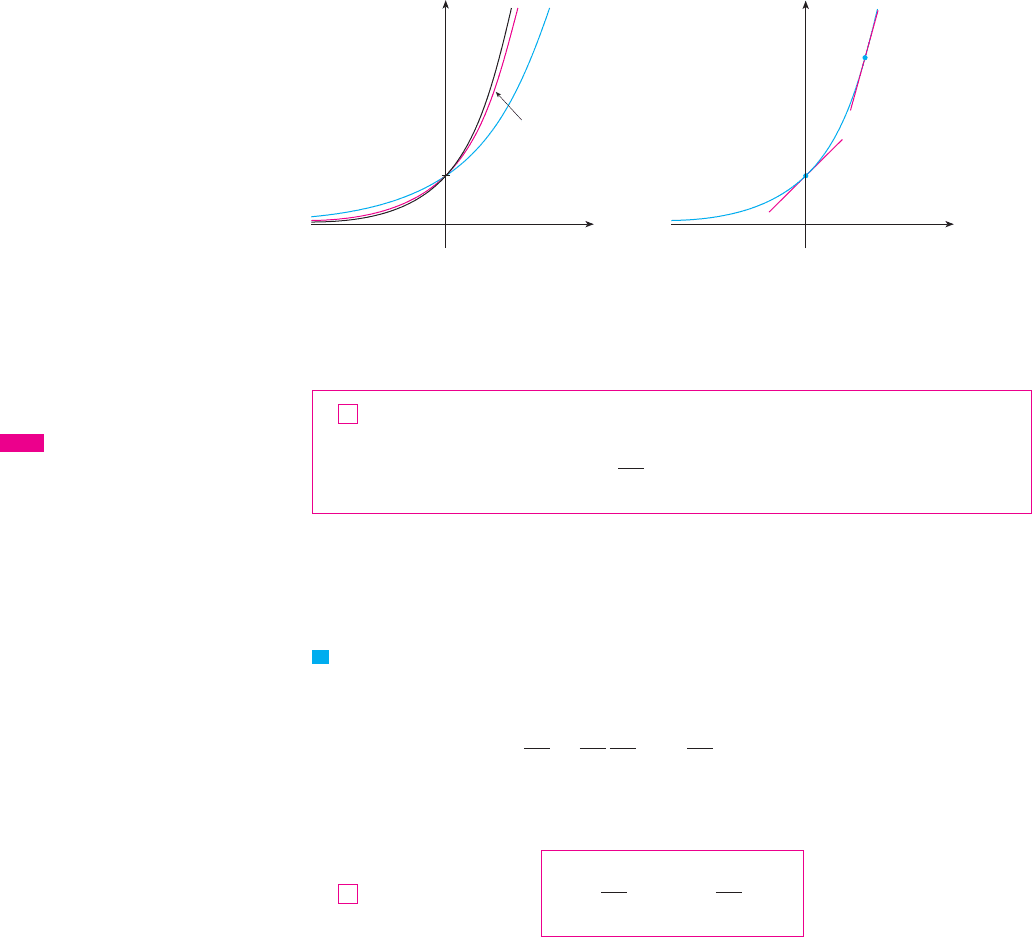
(See Figures 10 and 11.) We call the function the natural exponential function.
If we put and, therefore, in Equation 4, it becomes the following impor-
tant differentiation formula.
DERIVATIVE OF THE NATURAL EXPONENTIAL FUNCTION
Thus the exponential function has the property that it is its own derivative.
The geometrical significance of this fact is that the slope of a tangent line to the curve
at any point is equal to the -coordinate of the point (see Figure 11).
EXAMPLE 2 Differentiate the function .
SOLUTION To use the Chain Rule, we let . Then we have , so
M
In general if we combine Formula 8 with the Chain Rule, as in Example 2, we get
EXAMPLE 3 Find if .
SOLUTION Using Formula 9 and the Product Rule, we have
M
We have seen that is a number that lies somewhere between 2 and 3, but we can
use Equation 4 to estimate the numerical value of more accurately. Let . Then
. If , then from Equation 4 we have , where the value of k isf &!x" ! k2
x
f !x" ! 2
x
e
x
! 2
cx
e ! 2
c
e
e
y& ! e
!4x
!cos 5x"!5" " !sin 5x"e
!4x
!!4" ! e
!4x
!5 cos 5x ! 4 sin 5x"
y ! e
!4x
sin 5xy&
d
dx
!e
u
" ! e
u
du
dx
9
dy
dx
!
dy
du
du
dx
! e
u
du
dx
! e
tan x
sec
2
x
y ! e
u
u ! tan x
y ! e
tan x
V
yy ! e
x
f !x" ! e
x
d
dx
!e
x
" ! e
x
8
f &!0" ! 1a ! e
F I G U R E 1 1
0
y
1
x
slope=1
slope=e®
y=e®
{x,e®}
0
y
1
x
y=2®
y=e®
y=3®
F I G U R E 1 0
f !x" ! e
x
398
|| ||
CHAPTER 7 INVERSE FUNCTIONS
Visual 7.2 /7.3* uses the slope-a-
scope to illustrate this formula.
TE C
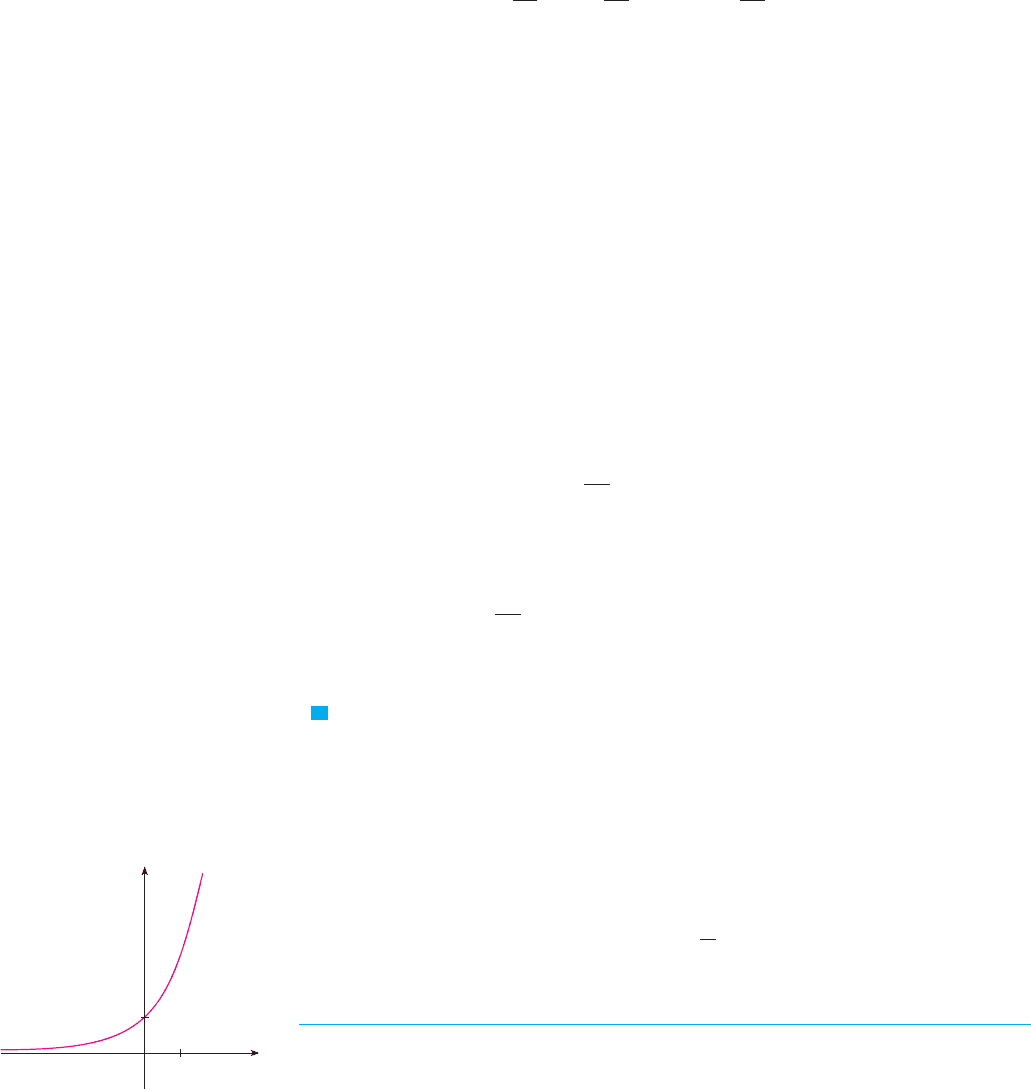
. Thus, by the Chain Rule,
Putting , we have , so and
It can be shown that the approximate value to 20 decimal places is
The decimal expansion of is nonrepeating because is an irrational number.
EXAMPLE 4 In Example 6 in Section 3.7 we considered a population of bacteria cells in
a homogeneous nutrient medium. We showed that if the population doubles every hour,
then the population after hours is
where is the initial population. Now we can use (4) and (5) to compute the growth
rate:
For instance, if the initial population is cells, then the growth rate after two
hours is
M
EXAMPLE 5 Find the absolute maximum value of the function .
SOLUTION We differentiate to find any critical numbers:
Since exponential functions are always positive, we see that when ,
that is, when . Similarly, when . By the First Derivative Test for
Absolute Extreme Values, has an absolute maximum value when and the value is
M
EXPONENTIAL GRAPHS
The exponential function is one of the most frequently occurring functions in
calculus and its applications, so it is important to be familiar with its graph (Figure 12) and
properties. We summarize these properties as follows, using the fact that this function
is just a special case of the exponential functions considered in Theorem 2 but with base
.a ! e # 1
f !x" ! e
x
f !1" ! !1"e
!1
!
1
e
$ 0.37
x ! 1f
x # 1f &!x"
$
0x
$
1
1 ! x # 0f &!x" # 0
f &!x" ! xe
!x
!!1" " e
!x
!1" ! e
!x
!1 ! x"
f !x" ! xe
!x
V
! !4000"!0.693147" $ 2773 cells#h
dn
dt
%
t!2
$ !1000"!0.693147"2
t
&
t!2
n
0
! 1000
dn
dt
$ n
0
!0.693147"2
t
n
0
n ! n
0
2
t
t
ee
e $ 2.71828182845904523536
e ! 2
1#k
$ 2
1#0.693147
$ 2.71828
c ! 1#k1 ! ckx ! 0
e
x
!
d
dx
!e
x
" !
d
dx
!2
cx
" ! k 2
cx
d
dx
!cx" ! ck2
cx
f &!0" $ 0.693147
SECTION 7.2 EXPONENTIAL FUNCTIONS AND THEIR DERIVATIVES
|| ||
399
N The rate of growth is proportional to the size
of the population.
y=´
x0
1
y
1
F I G U R E 1 2
The natural exponential function

PROPERTIES OF THE NATURAL EXPONENTIAL FUNCTION The exponential func-
tion is an increasing continuous function with domain and range
. Thus for all . Also
So the -axis is a horizontal asymptote of .
EXAMPLE 6 Find .
SOLUTION We divide numerator and denominator by :
We have used the fact that as and so
M
EXAMPLE 7 Use the first and second derivatives of , together with asymp-
totes, to sketch its graph.
SOLUTION Notice that the domain of is , so we check for vertical asymptotes
by computing the left and right limits as . As , we know that ,
so
and this shows that is a vertical asymptote. As , we have ,
so
As , we have and so
This shows that is a horizontal asymptote.
Now let’s compute the derivative. The Chain Rule gives
Since and for all , we have for all . Thus is
decreasing on and on . There is no critical number, so the function has no
maximum or minimum. The second derivative is
f '!x" ! !
x
2
e
1#x
!!1#x
2
" ! e
1#x
!2x"
x
4
!
e
1#x
!2x " 1"
x
4
!0, %"!!%, 0"
fx " 0f &!x"
$
0x " 0x
2
# 0e
1#x
# 0
f &!x" ! !
e
1#x
x
2
y ! 1
lim
x l(%
e
1#x
! e
0
! 1
1#x l 0x l (%
lim
x
l
0
!
e
1#x
! lim
t
l
!%
e
t
! 0
t ! 1#x l !%x l 0
!
x ! 0
lim
x
l
0
"
e
1#x
! lim
t
l
%
e
t
! %
t ! 1#x l %x l 0
"
x l 0
'x
&
x " 0(f
f !x" ! e
1#x
lim
x l %
e
!2x
! lim
t l !%
e
t
! 0
x l %t ! !2x l !%
!
1
1 " 0
! 1
lim
x
l
%
e
2x
e
2x
" 1
! lim
x
l
%
1
1 " e
!2x
!
1
1 " lim
x
l
%
e
!2x
e
2x
lim
x l %
e
2x
e
2x
" 1
f !x" ! e
x
x
lim
x l %
e
x
! %lim
x l !%
e
x
! 0
xe
x
# 0!0, %"
!f !x" ! e
x
10
400
|| ||
CHAPTER 7 INVERSE FUNCTIONS
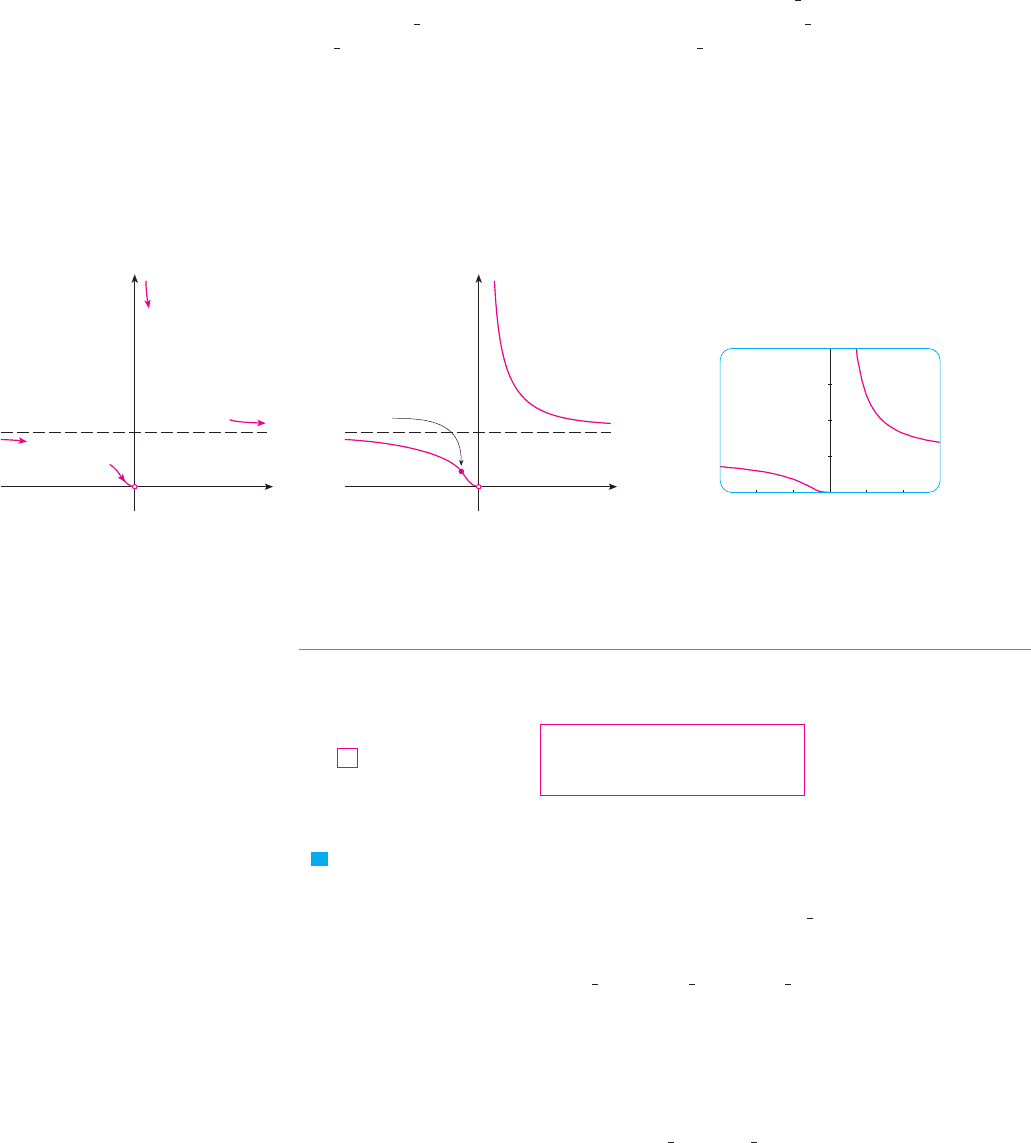
Since and , we have when and
when . So the curve is concave downward on and concave upward on
and on . The inflection point is .
To sketch the graph of we first draw the horizontal asymptote (as a dashed
line), together with the parts of the curve near the asymptotes in a preliminary sketch
[Figure 13(a)]. These parts reflect the information concerning limits and the fact that is
decreasing on both and . Notice that we have indicated that as
even though does not exist. In Figure 13(b) we finish the sketch by incorpo-
rating the information concerning concavity and the inflection point. In Figure 13(c) we
check our work with a graphing device.
M
INTEGRATION
Because the exponential function has a simple derivative, its integral is also simple:
EXAMPLE 8 Evaluate .
SOLUTION We substitute . Then , so and
M
EXAMPLE 9 Find the area under the curve from 0 to l.
SOLUTION The area is
MA !
y
1
0
e
!3x
dx ! !
1
3
e
!3x
]
0
1
!
1
3
!1 ! e
!3
"
y ! e
!3x
y
x
2
e
x
3
dx !
1
3
y
e
u
du !
1
3
e
u
" C !
1
3
e
x
3
" C
x
2
dx !
1
3
dudu ! 3x
2
dxu ! x
3
y
x
2
e
x
3
dx
V
y
e
x
dx ! e
x
" C
11
y ! e
x
(a) Preliminary sketch (b) Finished sketch
F I G U R E 1 3
(c) Computer confirmation
4
0
_3 3
x
0
y
y=1
y=‰
inflection
point
x
0
y
y=1
f !0"x l 0
!
f !x" l 0!0, %"!!%, 0"
f
y ! 1f
(
!
1
2
, e
!2
)
!0, %"
(
!
1
2
, 0
)
(
!%, !
1
2
)
x
$
!
1
2
f '!x"
$
0!x " 0"x # !
1
2
f '!x" # 0x
4
# 0e
1#x
# 0
SECTION 7.2 EXPONENTIAL FUNCTIONS AND THEIR DERIVATIVES
|| ||
401
